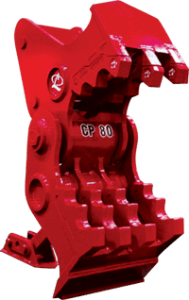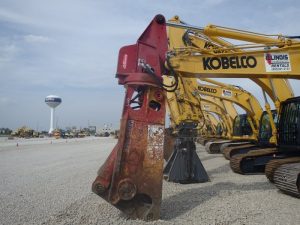Proper Maintenance is Key To Getting the Most Out Of A Mobile Shear
It’s the same with any tool. If you take care of it, it will last longer. And the more expensive the tool, the more important this concept becomes. A mobile shear is a critical component to keep your business running productively, and you can easily expect to get hundreds of hours of work from it.
You aren’t doing any of these things are you?
 Using your mobile shear for unintended purposes. Both rotating shears and concrete processors are often mistakenly used to pry or twist material. They’re only designed for positioning, to save excavator tracking time and handle vertical processing.
Using your mobile shear for unintended purposes. Both rotating shears and concrete processors are often mistakenly used to pry or twist material. They’re only designed for positioning, to save excavator tracking time and handle vertical processing.- Using your excavator’s tractive force to drag materials with the shear. This often occurs on demolition jobs, but it puts undue stress on the attachment, and that stresses components back up the line. Picking up heavy objects off-center can have the same effect.
- Allowing the mobile shear to drag on the ground while you’re cutting. You’re effectively grinding it down, and that’s made worse by the material’s weight and power of the excavator.
- Reaching in- A mobile shear is designed to cut individual pieces of material, not an entire pile at a time.
- Using your mobile shear as a battering ram. That can be tempting, but the shear isn’t engineered for breaking up material, especially items that are harder than the shear itself.
Match the right tool to the job.
You don’t have to guess, just read and understand the manufacturer’s operating guide. Your OEM or dealer can advise you about proper attachment selection and sizing, which becomes even more critical if you’re working at heights.
Mobile shears are designed to take one bite at a time, rather than chopping or “chewing” on material. Use your concrete cracker to break away large chunks of concrete, then use your concrete pulverizer to break it up and separate out the rebar. Cracking attachments are engineered to work with a specific weight excavator, and a mis-match can cause significant damage to one or the other.
Daily inspection and maintenance are essential to ensure clearance dimensions remain within spec. By the time you realize key parts are out of alignment, it will be too late to avert damage.
What could go wrong?
At the very least, poor performance, longer cycle times or operator safety concerns. But it’s more likely that continued mis-use will cause serious damage. That could include:
- Premature replacement of wear items such as cutting surfaces, teeth, etc.
- Damage to carrier brackets, the boom, hydraulic components, pins and structural components.
- Cylinder failure.
- Failed O-rings and other seals.
- Chin plate wear that allows dirt to get between the blades so they also wear prematurely.
 Material can become jammed between the guide blades. Unbalanced loads can tip, even the excavator could tip over. You can push the drive shaft right through the gearbox, or at the least damage the gearbox cover or motor housing. Excessive concussive shock can cause decompression spikes to damage components of your shear and excavator hydraulic systems. Keep doing this and you can actually crack your shear’s jaws.
Material can become jammed between the guide blades. Unbalanced loads can tip, even the excavator could tip over. You can push the drive shaft right through the gearbox, or at the least damage the gearbox cover or motor housing. Excessive concussive shock can cause decompression spikes to damage components of your shear and excavator hydraulic systems. Keep doing this and you can actually crack your shear’s jaws.
These things cost money — a lot of it in some instances. And it’s entirely unnecessary.
What could really go sideways is your bottom line. Construction equipment is expensive. You expect it to last many years, working in conditions that are the polar opposite of gentle. You need to work as fast as possible in order to be profitable. But mistreating your mobile shear could cost you tens of thousands of dollars – or even more – in repairs and lost job time.
On the other hand, proper usage and regular maintenance are all it takes to ensure you get the most from your investment.
